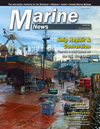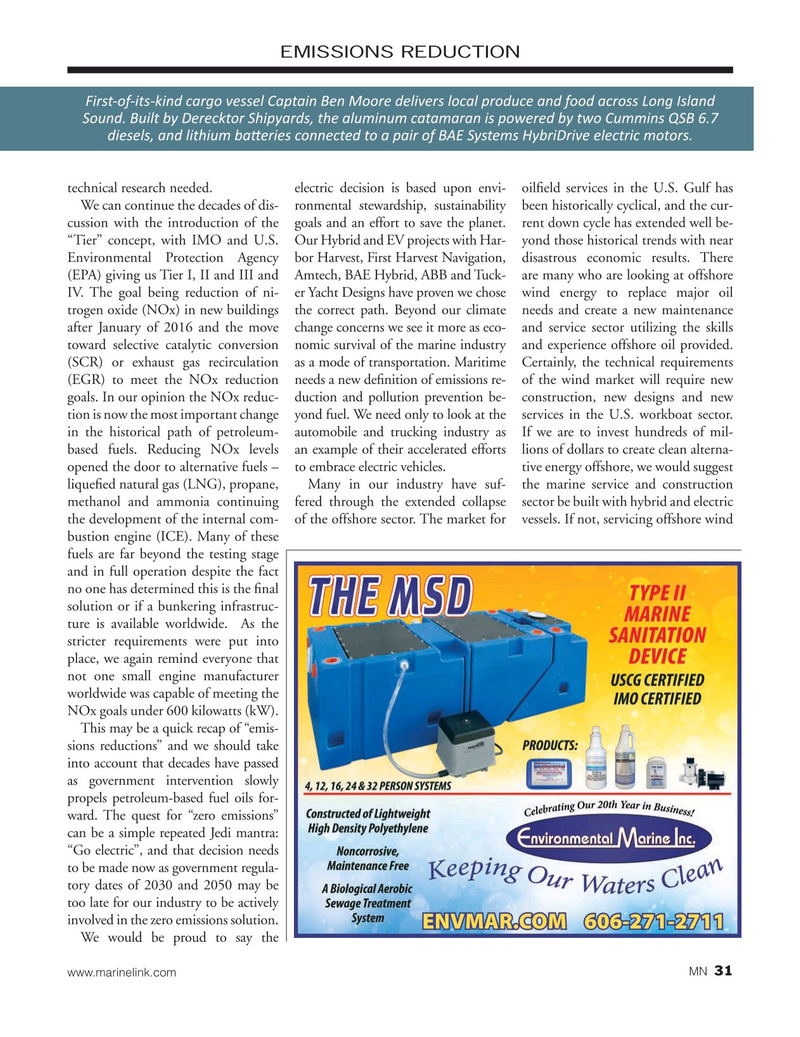
Page 31: of Marine News Magazine (March 2020)
Workboat Conversion & Repair
Read this page in Pdf, Flash or Html5 edition of March 2020 Marine News Magazine
EMISSIONS REDUCTION
First-of-its-kind cargo vessel Captain Ben Moore delivers local produce and food across Long Island
Sound. Built by Derecktor Shipyards, the aluminum catamaran is powered by two Cummins QSB 6.7 diesels, and lithium bat eries connected to a pair of BAE Systems HybriDrive electric motors. technical research needed. electric decision is based upon envi- oil? eld services in the U.S. Gulf has
We can continue the decades of dis- ronmental stewardship, sustainability been historically cyclical, and the cur- cussion with the introduction of the goals and an effort to save the planet. rent down cycle has extended well be- “Tier” concept, with IMO and U.S. Our Hybrid and EV projects with Har- yond those historical trends with near
Environmental Protection Agency bor Harvest, First Harvest Navigation, disastrous economic results. There (EPA) giving us Tier I, II and III and Amtech, BAE Hybrid, ABB and Tuck- are many who are looking at offshore
IV. The goal being reduction of ni- er Yacht Designs have proven we chose wind energy to replace major oil trogen oxide (NOx) in new buildings the correct path. Beyond our climate needs and create a new maintenance after January of 2016 and the move change concerns we see it more as eco- and service sector utilizing the skills toward selective catalytic conversion nomic survival of the marine industry and experience offshore oil provided. (SCR) or exhaust gas recirculation as a mode of transportation. Maritime Certainly, the technical requirements (EGR) to meet the NOx reduction needs a new de? nition of emissions re- of the wind market will require new goals. In our opinion the NOx reduc- duction and pollution prevention be- construction, new designs and new tion is now the most important change yond fuel. We need only to look at the services in the U.S. workboat sector. in the historical path of petroleum- automobile and trucking industry as If we are to invest hundreds of mil- based fuels. Reducing NOx levels an example of their accelerated efforts lions of dollars to create clean alterna- opened the door to alternative fuels – to embrace electric vehicles. tive energy offshore, we would suggest lique? ed natural gas (LNG), propane, Many in our industry have suf- the marine service and construction methanol and ammonia continuing fered through the extended collapse sector be built with hybrid and electric the development of the internal com- of the offshore sector. The market for vessels. If not, servicing offshore wind bustion engine (ICE). Many of these fuels are far beyond the testing stage and in full operation despite the fact no one has determined this is the ? nal solution or if a bunkering infrastruc- ture is available worldwide. As the stricter requirements were put into place, we again remind everyone that not one small engine manufacturer worldwide was capable of meeting the
NOx goals under 600 kilowatts (kW).
This may be a quick recap of “emis- sions reductions” and we should take into account that decades have passed as government intervention slowly propels petroleum-based fuel oils for- ward. The quest for “zero emissions” can be a simple repeated Jedi mantra: “Go electric”, and that decision needs to be made now as government regula- tory dates of 2030 and 2050 may be too late for our industry to be actively involved in the zero emissions solution.
We would be proud to say the 31 www.marinelink.com MN

 30
30

 32
32
